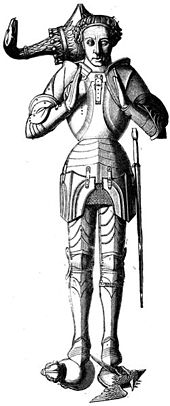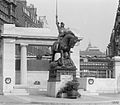Cavalry of the Empire Memorial

The Cavalry of the Empire Memorial, also known as the Cavalry Memorial, is a war memorial in Hyde Park, London. It commemorates the service of cavalry regiments in the First and Second World Wars. It became a Grade II listed building in 1987, and was promoted to Grade II* in November 2014.
Background
A committee was formed in early 1920 to consider a proposal for a memorial in London to the cavalrymen who had served in the First World War. According to figures in Volume 8 of the History of the British Cavalry 1816–1919 by
Sir
Design

For the memorial, Jones designed a bronze equestrian statue of
The statue was cast from guns captured by the cavalry in the First World War, and mounted on a Portland stone pedestal which bears an inscription, extended after the Second World War to read:
"ERECTED // BY THE // CAVALRY OF THE EMPIRE // IN MEMORY OF // COMRADES // WHO GAVE THEIR LIVES // IN THE WAR // 1914–1919 // ALSO // IN THE WAR // 1939–1945"
Brunet designed a classical backdrop for the statue, built with Portland stone, which shielded the memorial from Park Lane. The backdrop housed a bronze plaque listing the 150 cavalry units from Australia, Canada, India, New Zealand, Pakistan and the UK, that served in the forces of the British Empire in the First World War, along with the names of four British cavalry officers who became Field Marshals: Haig, French, Allenby and Robertson.
Reception
The memorial was unveiled on 21 May 1924 by Field Marshal
As Park Lane was widened in 1960, the memorial was moved to a new site about 300 metres (980 ft) further west in 1961, along the Horse Ride beside Serpentine Road, near the Hyde Park bandstand, and re-erected on a granite base. The backdrop was not reconstructed: instead, the bronze plaque was mounted on a granite screen behind the relocated statue.
Nearby is the memorial to the soldiers of the Household Cavalry who were killed in the Hyde Park and Regent's Park bombings in 1982.
-
The memorial before the Second World War, in its original position with stone backdrop
-
Setting and panels on screen behind
-
Inscription
-
Detail of frieze
See also
References
- Historic England. "The Cavalry Memorial on north side of Serpentine Road, west of statue of Achilles, Hyde Park W2 (1278118)". National Heritage List for England. Retrieved 9 August 2015.
- Cavalry Memorial, Stanhope Gate, Hyde Park Corner, The Western Front Association
- Cavalry Memorial, royalparks.org.uk
- Cavalry Of The Empire – WW1, Imperial War Museum
- The Cavalry Memorial, Department of Veteran Affairs, Australian Government
- Cavalry of the Empire Memorial, ww1cemeteries.com




